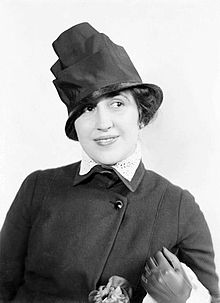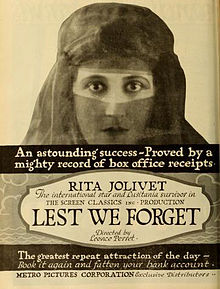Rita Jolivet
Rita Jolivet , nee Marguerite Lucile Jolivet (born September 25, 1884 in Castleton , Richmond County , New York , † March 2, 1971 in Nice ) was an American theater and silent film actress of French origin who was active in the 1910s and 1920s.
Origin and family
According to her own statements, Rita Jolivet came to Paris in 1894 , but actually came to New York State in 1884 as the daughter of the American winemaker Charles Eugene Jolivet (1840–1928) and his French wife, the concert musician Pauline Hélène Jolivet, née. Vaillant (1857–1957), to the world. She had two siblings, Inez Henriette (1881-1915) and Alfred Eugene (1893-1958). Jolivet came from an old family; a maternal ancestor was a lady-in-waiting for Napoléon III. been. Her father was from Carmansville , New York State , and her mother from Paris. Charles Jolivet and Pauline Vaillant had married in 1879 against the wishes of Pauline's parents.
Jolivet's roots can be traced back to the French Revolution , during which many members of her family were guillotined . In addition, most of her family members had excelled in the musical arts such as singing or mastering various instruments. Her sister Inez, for example, followed in her mother's footsteps and trained as a concert pianist with Henri Berthelier and Johannes Wolf . She performed under the stage name Inez Vernon in the Metropolitan Opera in New York and was also very successful in Europe, where she was honored by King Edward VII of England and the Russian Tsar Nicholas II, among others .
As a child, Jolivet had stage appearances in English and French. To further her education, her mother sent her to London , where she took acting classes, studied pantomime and learned to dance at the Opéra-Comique .
Jolivet is the great-great-aunt of the Canadian actor Finn Wolfhard . His mother, Mary Jolivet Wolfhard, is the granddaughter of Jolivet's brother Alfred.
Career
In 1903 Jolivet got her first role as "Beatrice" in William Poel's play Much Ado About Nothing , followed by The Gentleman of Verona . Her other early characters included the female title role in Romeo and Juliet , "Lucy" in Beauty and the Barge, and "Catharine" in Jasper Bright . Between 1906 and 1908 she appeared increasingly in Paris with the comedian Gallipeaux and graduated from school at the same time. In 1909 she resumed her acting career and played the Russian Grand Duchess "Ina Drovinski" in the comedy Eccentric Lord Comberdene .
After turning back to stage acting, she moved to New York around 1910 and got her first lead role on Broadway in 1911 in the play Kismet by Edward Knoblauch . Her mentor and sponsor was the then very influential theater producer Charles Frohman , who gave her many leading roles at the Haymarket Theater , including in Lady Flirt and The Cabinet Minister . Her most important pieces during this time included What it Means to a Woman and Where Ignorance is Bliss . Jolivet was very aware of their audience and very eager to meet the demands and meet the expectations. She saw herself as a perfectionist .
In 1914 she made her Hollywood debut with Fata Morgana , but only made her breakthrough in 1915 in the role of "Delight Warren" in Cecil B. DeMille's The Unafraid . She tried to build on this success and played the next role as "Josie Richards" in Broadway Jones . In the fall of 1915 she signed a new film contract in Italy and worked there on many Italian films such as Zvani , Monna Vanna , Cuore ed arte and Wolfson's last gala screening .
She made two films about the sinking of the Lusitania (see below). The first, Her Redemption from 1916, received little attention, but Lest We Forget (1918) became one of her most successful films. She went on tour with the film and gave a lot of interviews on the subject. In principle - and in contrast to many other survivors - she never had any problems talking about her experiences with the sinking of the ship. Then she devoted herself to other roles and played, among others, the Byzantine Empress Theodora in the production of the same name (1919) and the leading female role in The Bride's Confession (1921). In the twenties , Jolivet was no longer seen on screen that often, she made only a few films such as The Fall of an Empress or Le mariage de minuit , all of which were very successful.
At the time of their second divorce, Jolivet decided to end her career. Some of her last major films were Phi-Phi and Le Marchand de bonheur (both 1926). In 1927 she finally said goodbye to the stage and the screen.
Survivors of the RMS Lusitania
During the First World War , Rita Jolivet survived the sinking of the British luxury steamer RMS Lusitania by a German submarine , killing 1,198 people.
On Saturday, May 1, 1915 went to New York on board the passenger ship to shooting to Italy to travel. Also on board were Charles Frohman and other acquaintances from the New York theater scene such as Justus Forman , Josephine Brandell and Charles Klein . She was surprised to see her brother-in-law George Vernon on board, who was traveling to England on business (he was her sister Inez's husband). Her friend, the actress Ellen Terry , wanted to persuade her to travel with her and Isadora Duncan to England on the New York steamer , since it sailed under the neutral American flag and was therefore considered safe from German submarines, but Jolivet would not let her change your mind. At 8 a.m. on the day of departure, she booked a first class crossing on the Lusitania and occupied cabin D-15, which she was disappointed with as it was a small, windowless interior cabin.
When the ocean liner was sunk by a German submarine off the coast of southern Ireland on May 7, she buckled on a life jacket and also took her mother-of-pearl revolver with her to shoot herself in the water if necessary. She was afraid of drowning and under no circumstances did she want to die in agony. She stood at the railing with Charles Frohman and the rest of the group until the ship went down and they were washed into the sea. Jolivet was caught in the suction of the ship and pulled under the water. She managed to cling to a capsized lifeboat and was eventually recovered and taken to Queenstown (now Cobh ) by a rescue ship. She and actress Josephine Brandell were the only survivors from their group; Jolivet hadn't even thought of her revolver in the chaos. Her brother-in-law, George Ley Vernon (1869–1915), had died in the sinking. His widow, Jolivet's sister Inez Vernon, couldn't cope with his death. She was found dead in her New York City apartment (Sumner Apartments, 31 West 11th Street, Apartment 19) on July 23, 1915. She shot herself.
Marriages and personal lives
On November 14, 1908, Jolivet married Alfred Charles Stern, but lived apart from him for most of the time and divorced a short time later.
On January 27, 1916 Jolivet married the Italian nobleman Comte (Count) Giuseppe de Cippico (1880-1941) in Kew Gardens , Surrey , England and changed her real first name Marguerite to the Italian Margherita. She was well aware of her new status as Countess and enjoyed all the amenities that came with it. In addition, Jolivet was very vain and geared towards youth, already at the age of 26 the actress made herself younger, a practice that she would pursue for the rest of her life. In 1924, she stated her age as 28, but she was already 40 (on her deathbed she claimed to be “only 77”, but she was 86).
Jolivet's brother Alfred married the London-born American Beatrice Latouche Witherbee (1890–1977) on November 25, 1919, who, like Jolivet, was a Lusitania survivor and was divorced from her first husband. She had lost her mother and three-year-old son from her first marriage in the downfall. Beatrice Witherbee and Alfred Jolivet met because Rita Jolivet took in Mrs. Witherbee after the disaster in her London apartment. The marriage resulted in the son Lawrence Charles Latouche Jolivet († March 16, 2005), Rita's only nephew, on April 11, 1920.
Jolivet's second marriage crumbled and divorced in 1926. On April 26, 1928, she married the wealthy Canadian James Bryce-Allan (1893-1960), a cousin of Sir Montagu Allan , who owned the Canadian shipping company Allan Line . Allan's wife was also a survivor of the Lusitania disaster; his two daughters were killed in the process. The wedding was celebrated at great expense in the Church of Scotland in Paris, the couple then settled in a castle in Renfrewshire ( Scotland ). Jolivet and Bryce-Allan led a manorial life there. They organized picnics and grouse hunts on the castle grounds, celebrated parties with representatives from the nobility , business and the artistic scene and organized a large Christmas parade in Glasgow every year . They had second homes in Monte Carlo and Paris, and owned a yacht called Scotia , which they used to cruise the Mediterranean . The couple also leased Ince Castle , a 17th century country house in Cornwall .
In the early 1930s , Jolivet and Bryce-Allan sold their castle and moved to New York, where Bryce-Allan was henceforth director of the Coates cotton processing company. In May 1960, James Bryce-Allan died in a flash, and Rita Jolivet withdrew even more into private life. She died in Nice in 1971. She danced the jig in a friend's house , fell badly and died of her injuries in the hospital. While she was still on her deathbed, she kept a secret about her age, which she said was 77. According to her will , she was not buried, but had her ashes scattered.
Broadway plays
- Kismet (1911)
- Where Ignorance is Bliss (1913)
- A Thousand Years Ago (1914)
- What it Means to a Woman (1914)
- Mrs. Boltay's Daughters (1915)
Filmography
- 1914: Fata Morgana
- 1915: The Unafraid
- 1915: Zvani
- 1915: The Masque of Life
- 1915: Monna Vanna
- 1915: La Mano di Fatma
- 1915: Cuore ed arte
- 1916: Love's Sacrifice
- 1916: The Honor to Die
- 1916: Her Redemption
- 1916: An International Marriage
- 1917: One Law For Both
- 1917: Quello che videro I miei occhi
- 1917: National Red Cross Pageant
- 1918: Read We Forget
- 1919: Theodora
- 1921: The Bride's Confession
- 1922: Roger la Honte
- 1922: The Fall of an Empress
- 1923: La marriage de minuit
- 1926: Phi-Phi
- 1926: Le Marchand de bonheur
Individual proof
Web links
- Rita Jolivet in the Internet Movie Database (English)
- Rita Jolivet in the Internet Broadway Database (English)
- http://www.revdma2.com/Rita.html
- Rita Jolivet at powerset.com
- Filmography at fandango.com
- http://www.rmslusitania.info/pages/saloon_class/jolivet_rita.html
- http://www.encyclopedia-titanica.org/discus/messages/10245/90010.html
- http://query.nytimes.com/mem/archive-free/pdf?_r=1&res=9A04E7DD103BEE3ABC4052DFB2668383609EDE&oref=slogin
- http://query.nytimes.com/mem/archive-free/pdf?_r=1&res=940CE5D71038E633A25750C2A9619C946496D6CF&oref=slogin
- http://movies.nytimes.com/movie/review?res=9E03E7D7103FE233A2575AC0A9659C946796D6CF&scp=4&sq=Rita%20Jolivet&st=cse
| personal data | |
|---|---|
| SURNAME | Jolivet, Rita |
| ALTERNATIVE NAMES | Jolivet, Marguerite Lucile (maiden name) |
| BRIEF DESCRIPTION | French theater and silent film actress |
| DATE OF BIRTH | September 25, 1884 |
| PLACE OF BIRTH | Castleton , Richmond County , New York |
| DATE OF DEATH | March 2nd 1971 |
| Place of death | Nice , France |




